In this post, you are going to learn everything you need to know about diastasis recti.
Specifically, you’ll learn:
- What is it,
- Why it happens, and
- How to tell if you have it.
I’ll also point you to a resource on how to treat it with exercise.
Are you ready?
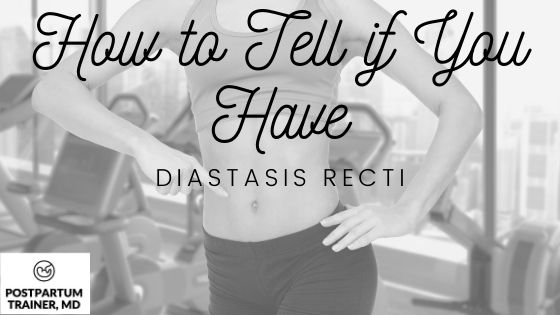
How To Tell If You Have Diastasis Recti
There is one simple test to determine if you have diastasis recti that you can do at home.
Its a modified curl-up.
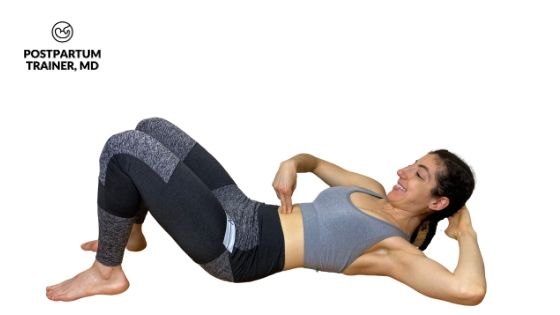
Here’s how to do it.
- Lie on your back with your knees bent and feet flat on the floor.
- Take one hand and place your fingers right above your belly button.
- Next, elevate your head off the floor as if you were going to do a crunch – but do not lift your shoulders off the floor.
- If you feel your fingers sink into your abdomen (and it feels a bit squishy) then you have abdominal wall separation.
You can check in three different locations.
- At your belly button
- Above your belly button
- Below your belly button
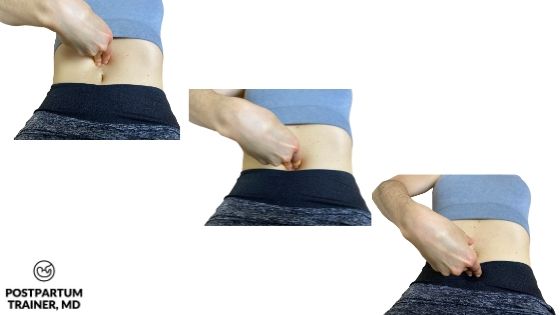
Unfortunately, there is no actual medical standard to diagnose the condition.
There is controversy over how much abdominal separation is considered normal, and how much is abnormal.
Also, the degree of abdominal wall separation does not correlate with symptoms.
With that said, most people agree that 2 centimeters (about two finger widths) is abnormal.
Other Diastasis Recti Symptoms/Associations
Other common symptoms that occur with diastasis recti include the following:
- A bulge or a pooch in your stomach,
- A general feeling of weakness in the abdomen,
- Abdominal protrusion of internal organs (known as coming)
- Lower back pain
Any weakening of the ab muscles can lead to changes in your pelvic posture, placing excessive pressure on the lower back.
Diastasis recti may also be associated with pelvic floor dysfunction such as urinary incontinence and pelvic organ prolapse.
How To Check For Diastasis Recti If You’re Overweight
If the modified curl-up test cannot be done due to excess fat in your abdomen, then you do have another option.
An ultrasound or a CT scan can make the diagnosis, but you will need your doctor to order the imaging study.
Okay, now let’s go over some general questions regarding DR.
What Is Diastasis Recti?
Diastasis recti is a condition that occurs when your abdominal muscles separate along the midline. The connective tissue between the two rectus muscles is known as the linea alba.
This condition is most commonly seen in postpartum women, but it can also happen in men, and in infants.
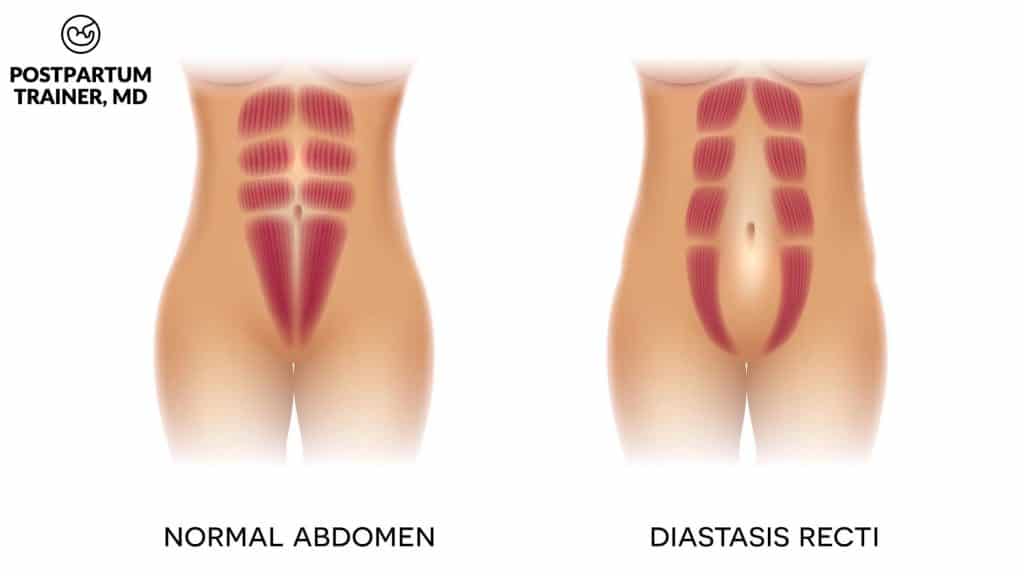
Why Does It Occur?
Separation of your rectus abdomini muscles is thought to occur from a weakness of the linea alba. This could be due to excessive pressure placed on your abdominal wall from a growing uterus.
However, this condition can be acquired, meaning you are born with it.
As such, you are either
- born with rectus diastasis, or
- you are more likely to develop it with any stretching of your abdomen as seen in pregnant women or in obesity
How Common Is It?
Diastasis recti is thought to occur in anywhere from 30-60% of women postnatally.
Another study found that it was present in up to 35-39% of women who were 6 months postpartum using ultrasound to diagnose it.
Interestingly, that same study found that 100% of all 84 women tested, had it in the late third trimester (35th week of pregnancy.)
Can Diastasis Recti Be Prevented?
There is one thing that you can do to decrease your risk of developing diastasis recti.
Exercise!
I have an entire article on how to prevent diastasis recti that you could find here.
The gist is:
Improving your core strength pre-pregnancy has been found to reduce the risk by 35%!

In addition, there are other safe abdominal exercises you can do during pregnancy to build a strong core.
I discuss these over at 18 Safe Transverse Abdominis Exercises You Can Do In Pregnancy.
The other thing you can do is:
Maintain a normal BMI.
This is easier said than done, but obesity may increase your risk of abdominal wall separation.
Is There An Effective Treatment For Diastasis Recti?
As of right now, there is no clear cut treatment that cures diastasis recti.
But there’s good news.
Training your core muscles is a simple first-line treatment option that can certainly help.
But you must be careful.
It is important that you get clearance from your medical provider first before doing any kind of exercise activity- especially if you are postpartum.
If you are ~6 weeks postpartum, and your doctor has given you the green light, then you should give exercise a try.
Here’s how:
Strengthen The Transverse Abdominis Muscle (TVA)
The transverse abdominis is the deepest abdominal muscle that wraps around your abdomen like a corset.
It basically functions by compressing your abdomen and ribs.
The good news is:
You can train this muscle with very simple yet effective exercises such as diaphragmatic breathing and the posterior pelvic tilt.
Here’s what they look like:
Diaphragmatic Breathing
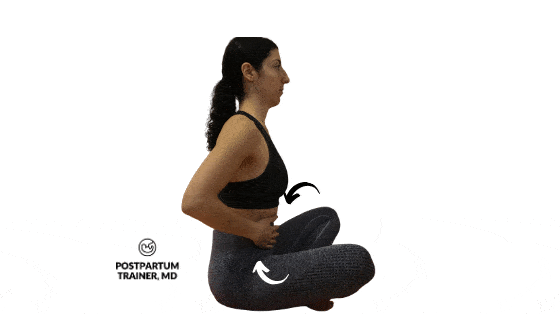
Focus on expanding your rib cage and not shrugging. I go over breathing exercises for diastasis recti in more detail here.
Posterior Pelvic Tilts
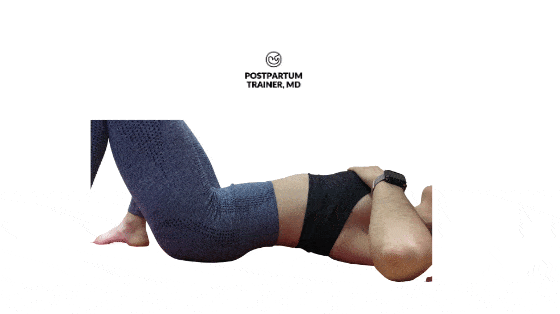
Focus on flattening your low back and contracting your abdominal musculature as you
Strengthen The Obliques
The other important muscle that you must strengthen is the oblique.
These muscles sit alongside your rectus abdominis muscle underneath your ribcage.
They are responsible flexing your spine laterally, and rotating your spine.
You can strengthen these muscles with static exercises such as modified side plank abductions and modified mountain climbers.
Here is what they look like:
Modified Side Plank Abductions
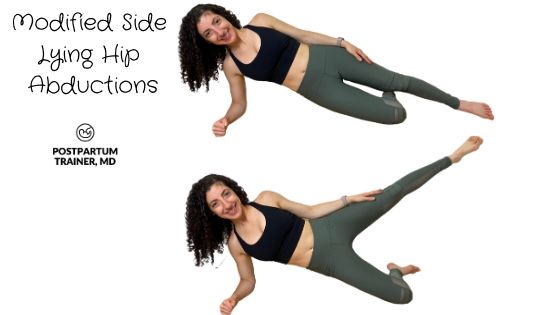
Modified Mountain Climbers
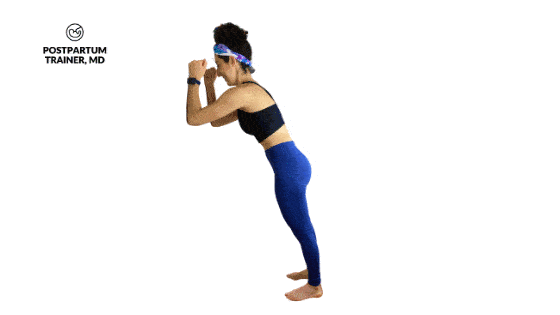
Focus on bringing one knee to the opposite elbow.
It’s important that you focus on these two core muscles and not the rectus to avoid worsening your abdominal wall separation.
Lastly, it’s a good idea to strengthen your pelvic floor muscles.
The kegel exercise is the best way to do this.
But don’t worry, you won’t have to figure this out all on your own!
100 Exercises For Diastasis Recti
I have a great resource for you to help you get started. It goes over 100 different exercises you can do to strengthen your core safely and effectively.
Check it out below.
100 Exercises For Diastasis Recti: The Complete List
When doing an exercise routine, you can check for progress every 2-3 weeks.
But it’s important that you do not get discouraged if you don’t see results right away.
You need to follow a program for at least 6-12 weeks to determine if it is working for you.
What Exercises Should You Avoid If You Have DR?
In general, there are a few exercises you should avoid if you have diastasis recti.
These include any exercise that causes a lot of abdominal pressure on your rectus abdominis.
Common examples include:
- Heavy lifting
- Sit-ups
- Twisting Exercises
- Planks
- Full Push-ups
That’s not to say you won’t ever be able to do these exercises.

In fact, I show you how to progress up to exercises like the plank in the post above.
What If Exercise Doesn’t Help?
If your ab muscle separation is causing you significant distress, and exercise has not helped, you can be referred for surgical repair.
Usually, this procedure is done by a Plastic Surgeon.
One of the most common surgeries is an abdominoplasty, aka “the tummy tuck.”
But first make sure you have given yourself an adequate amount of time to heal as it can take upwards of 6 months for your abdominal muscles to come back together.
Do Belly Bands Help?
Wearing an abdominal band or binder is a common method many women use to treat abdominal wall separation.
As of right now, there is no evidence that this will help reduce or treat diastasis recti.
With that said, some women prefer to wear the abdominal binder immediately postpartum for abdominal wall support when walking.
Related Questions
Is Diastasis Recti The Same As a Hernia?
Diastasis recti is not the same as an abdominal wall hernia.
A hernia occurs from a weakening or a defect (hole) in your fascia. Fascia is the connective tissue that holds your internal organs in place.
You may or may not have fascial weakness with diastasis.
Learn how to tell the difference between diastasis recti and an umbilical hernia here.
Can You Get Diastasis Recti In Pregnancy?
Yes, you can get diastasis recti in pregnancy. One study of 84 women found that all of them had diastasis recti (diagnosed by ultrasound) by 35 weeks of gestation.
The thought is that the expanding uterus exerts high amounts of pressure on the linea alba. This pressure weakens the linea alba allowing the rectus muscles to separate.
Can You Feel It Happening?
You can’t necessarily feel diastasis recti happening. It is a gradual process that occurs over the course of weeks to months.
That is why it is important to do core exercises before and even during pregnancy if possible.
Can you Fix Diastasis Recti Without Surgery?
The first-line treatment option for diastasis recti is conservative. This means a trial of exercise and weight loss.
I have created a Safe Diastasis Recti Exercise Program for New Moms that you could try at home.
If after 6-12 months you do not notice any improvement in your abdominal wall separation, then surgery may be necessary.
Always check with your healthcare provider for more personalized information.
Get Started With a DR 7 Day Challenge For Just $1
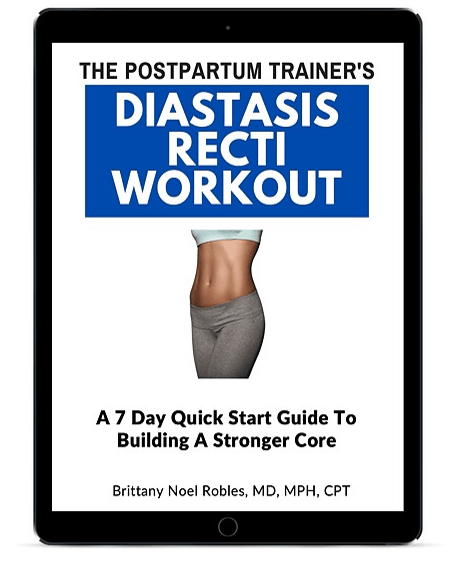
You can my a quick 7-day workout plan on the best exercises for diastasis recti with pictures in one convenient PDF for just $1. That way, you can print it out and have it with you as you go through the 20 min workout!
Final Words On How To Know If You Have Diastasis Recti
Diastasis recti is a common condition that can negatively impact your quality of life.
But the good news is, you have the power to do something about it!
Use the diastasis recti test above to see where you stand.
So, I want to hear from you.
When did you get diastasis recti?
What have you tried to fix it?
Comment below and let me know!
Related Posts
- 100 Effective Exercises for Diastasis Recti (PDF)
- Diastasis Recti After A C-Section
- How Long Does it Take to Heal from Diastasis Recti
Get Four Free Workouts To Help Strengthen Your Pelvic Floor & Heal Your Mommy Tummy!

Brittany Robles, MD, MPH, CPT
Brittany Robles is a full-time OBGYN physician, a NASM certified trainer, and a prenatal and postnatal fitness specialist. She holds a Master of Public Health degree in maternal health with a special interest in exercise and nutrition. She is also the co-author of The White Coat Trainer. Learn more about her here.
Sharing is Caring – Send This To A Mom In Need!
References:
- Fernandes da Mota PG, Pascoal AG, Carita AI, Bø K. Prevalence and risk factors of diastasis recti abdominis from late pregnancy to 6 months postpartum, and relationship with lumbo-pelvic pain. Man Ther. 2015 Feb;20(1):200-5. doi: 10.1016/j.math.2014.09.002. Epub 2014 Sep 19. PMID: 25282439.

Hello Dr Robles,
Very informative article! I delivered my second in September. I wanted to ask if you have ever heard of Navel Displacement? And if it is same as DR?
Hi Neha,
Unfortunately this is not something I am familiar with as I have never heard of navel displacement throughout my medical school or OBGYN training. Just from preliminary research it does not appear to be the same as diastasis recti.
I am a mom with an 18 year old. Since her birth I have had what I would describe as an oval egg of protrusion from right under my ribs to the bottom of my stomach. Is that diastasus recti? I also have worsening in continence issues.
Hey Marilyn,
Thanks so much for your comment.
It is never a bad idea to strengthen your core and pelvic floor muscles unless you have a contraindication to doing so.
In regards to the oval egg protrusion under your ribs and incontinence, it is best to get evaluated by a physician and pelvic floor therapist to better assist you and ensure you don’t have a hernia or something more concerning.
Best,
Brittany
Hello, I was trying to look up info on repairing a separated abdominal muscle. My friend has suffered with weakness in the belly for 9 years since her child was born by caesarian. She thinks that the surgeon did not sew her up properly after surgery. She wants to have a surgeon repair her now, and is hoping to regain strength to lift groceries and have energy she has lost for so long. Upon reading that the muscles heal with exercise I am confused why my friends stomach is not healed. She does dancing, modern & salsa.
Hi Heather,
Thank you for your comment! During pregnancy, the abdominal muscles become stretched and weakened which can lead to diastasis recti or an abdominal separation.
In order to improve the diastasis recti those muscles need to become strengthened. The way in which those muscles are strengthened is by exercise.
Your friend should receive medical clearance in order to start repairing her diastasis recti with exercise and once cleared she should start with gentle, beginner friendly abdominal exercises to strengthen her core. She should avoid any exercises that cause pain, discomfort or worsening of the abdominal separation.
Dance can definitely help strengthen the core if she learns how to activate her abdominal muscles while dancing.
Hope this helps!
I have DR but not from pregnancy. It’s actually from hernia surgery. I assume the same exercises help regardless of cause? Thank you so much for this resource!
Hi Kimberly,
Thank you so much for your comment.
If you have DR from hernia surgery you can definitely try these exercises to help strengthen and rebuild your core. As always make sure you have received clearance from your surgeon prior to exercising and if any of the exercises cause discomfort try a different exercise.
Good luck!
Hi Dr. Robles,
A friend of mine had twins just over a year ago and has mild diastasis recti. She wants to get back into exercising and lose about 1-15 more pounds. As long as her physician gives her the green light to exercise, do you think it is safe for her to incorporate resistance exercises starting with light dumbbells for her upper body (biceps, triceps, chest and back)? Also would lunges and other body weight exercises be ok to work in (without twisting movements)?
Hi Nora,
Thanks so much for the comment.
If your friend has received clearance to exercise she can definitely start an exercise routine using resistance bands, kettlebells and even dumbbells.
Squats, lunges, wall push-ups, and many other body weight exercises are great to incorporate as well.
As always she should listen to her body and if any movement causes her pain or discomfort she should stop doing it.
Hope this helps!
Thank you so much, this definitely helps!
Hi Dr. Robles,
I met with my friend today and shared the exercises and the guidelines you suggested. Your website/blog is very helpful! She did have a few questions I hope you can answer….
1-Does the tummy splint compression belt work? She wants to know if it’s worth getting one.
2-Should she be avoiding lifting heavy objects? She has twins (17 months) and a 3 and a half year old. Her stroller is 50 lbs, which she lifts in and out of the car. And the kids are 23 and 33 lbs.
3-Should she be stretching the abs before and after the exercises you listed?
She’s done a lot of research herself and is finding some conflicting views. Just was wondering what your thoughts are.
Thanks,
Nora
Hi Nora,
Abdominal binders and belts are beneficial to some women- if she finds it to be helpful she should definitely use one. It is more so for support and likely wont make any significant changes to her condition.
As far as lifting heavy objects and “stretching” her abs, I cannot give personalized advice, especially since I do not know her or her situation. It is best she seeks advice from her doctor/health care providers.
Hope this helps!
Ok great thank you. I will relay the information to her. Thanks for your time and advice 🙂
Hello! I’ve had Diastasis Recti for almost 2 yrs now and haven’t found a resource as helpful as yours till now!
What’s the frequency of exercises you recommend? 3 exercises x 3 reps each x 7 days a week (as an example)?
Hi Rebecca,
Thank you so much for your email and I am so glad you have found the Postpartum Trainer!
Generally you want to do three exercises a day for 3-4 sets performing anywhere from 5-12 reps depending on the exercise.
For more detailed information including a sample workout you could check out this article: https://postpartumtrainer.com/diastasis-recti-exercise-program/
Hope this helps!
I gave birth to twins 31 years ago and 12 years later a single birth. My OB told me that my abdominal muscle had split. I also had a c-section for both deliveries the first was a bikini cut the second was a vertical cut. I have also had an oophorectomy on my left side. I am wondering if there is any hope for my abdominal muscles. I am having severe low back pain and nerve pain down my legs. Will PT help? Or what?
Hi Vicky,
Thank you so much for your comment.
Strengthening your core is never a bad idea as your abdominal muscles are instrumental to having a healthy body, allowing you to maintain good posture, balance, stability and possibly alleviating back pain.
It is also possible that physical therapy can help you.
With that said, anytime you have severe pain, you should seek medical care as pain signifies something is wrong and it is never a good idea to ignore these things.
Your medical providers will be able to perform a thorough physical examination to determine the root cause.
Hope this helps!
This is amazing. I have given birth 3 times, the last time was 3 years ago and ever since I have been searching for information. Signed up for a course that cost a bunch of money but never had the motivation to do it. I’ve never found such useful information online as well as it being so accessible, so thank you so much!
Now that I’m finally post hernia surgery and have the go-ahead to get back into exercise, I’m so wary of doing more abdominal damage (I have a 3-finger gap). So I’m definitely going to start this and see how it goes.
Thank you.
Hi Aviva,
Thank you so much for your comment!
I would recommend you start low and go slow! Always listen to your body and avoid anything that causes pain and/or discomfort.
Best of luck!
Hi. I have a 21&19 year old. I have chronic lower back pain since giving birth that has effected my lifestyle the past five years. I am very active, normal body weight and strong. I have mild separation of my abdomen. I have been through many treatments: medical, therapy and alternative. I keep wondering if the separation is causing my back pain. And if an abdominalplasty could help. What are your thoughts abd experience?
Hi Kim,
Thank you so much for your comment.
It is hard to say for sure what is causing your back pain.
A weakened core can definitely manifest as back pain.
Before going for abdominoplasty I would recommend you get a thorough evaluation by a physical therapist with experience treating postpartum women.
Hope this helps!